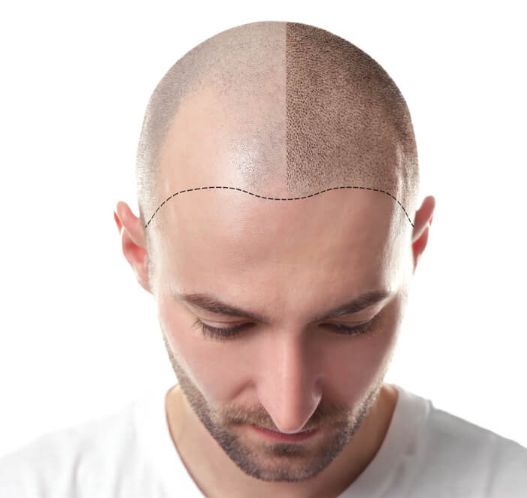HAIR TRANSPLANT

Hair loss may occur due to aging, various diseases, hormonal imbalances, genetics. In addition, hair loss may occur due to accidents and burns. Our hair is in an active cycle that includes growth (anagen phase), thinning (telogen phase), shedding (catagen phase).
Anagen phase: It is the phase with healthy growing hair. About 80-90% of all hair is in this phase. This phase lasts for 3 years.
Catagen phase: There is thinning of the hair, loss of pigment. It is a transitional period that lasts about 3-4 weeks.
Telogen phase: Approximately 10-15% of our hair is in this phase. Thinned hair with loss of pigment may fall out.
Then the formation starts again. Sometimes the hair follicles can enter the resting phase. This period lasts an average of 3 months. All these periods follow each other in the form of an intertwined cycle. It is normal to lose about 100 hairs per day in a normal person. Male pattern hair loss occurs in a certain way. The main reason is the androgen hormone. Today, approximately 50% of men have hair loss of various degrees. In female type hair loss, there is no loss from the forehead as in males. It would be a more common loss. Hormonal factors are important. Thyroid disorders, iron deficiency anemia, hair loss may occur in women after pregnancy and during menopause. There are basically two methods used in hair transplantation today. In the Fut method, a 2-3 cm strip is taken from the back of the scalp and transplanted. In this method, stitches are placed on the area from which the strip is taken. This place heals in 10 days. The number of roots transferred with this technique is limited. It should take 6-12 months for the area from which the scalp is taken to become suitable for the operation for the re-planting process.
Fue method
It is the basic method used today. Hair follicles are taken one by one with the help of a micromotor and a thin punch at the tip. The diameter of the punch used varies between 0.5-1 mm and does not damage the hair follicles. The removed hair is transferred to the balding area. Although roots are usually taken from the nape, it can be taken from anywhere with hair. The rooted area heals in a short 1-2 days. There is no trace left in this area. Because the holes from which the hair is taken are closed in a short time and the surrounding hair camouflages this area. Depending on the patient's hair density, approximately 2500-4000 grafts can be transplanted at one time. This means about 5000-6000 hair strand transfer.
Before hair transplant
Aspirin and similar blood thinners should be discontinued at least 10 days before the operation. Before the operation, your hair should be cut very short (a few mm) and thoroughly with shampoo. Do not use an additional hair care product. As an outfit, choose an outfit that you can wear comfortably and you can even come with a hat. Pre-operation planning and photography are done. The operation is usually performed with local anesthesia (rarely sedation). First, you lie face down and roots (grafts) are taken from the nape. Then it is laid on its back and the roots are transplanted to the planned areas in appropriate ways. This process can sometimes be repeated several times, the operation can be performed in different sessions on 2 separate days, or sometimes short breaks can be given.
Planning
Humans have about 100,000 hairs. In order for the transplanted hair to look normal, it will be sufficient to plant approximately 25-30 roots per square centimeter. This means that about 60 hairs were transplanted. This number can be obtained because some of the transplanted grafts are single, some are double or triple. Old photographs of the patient may be helpful in planning. The most important factor during planning is the correct creation of the front hairline. Oval, triangular, flat shapes can be planned, and the indented structure should be preserved naturally, not as a straight line. In addition, the area that is more prominent in men in the anterior upper part of the ear, called the temporal area, should be planned properly. After the area to be planted is determined, sowing with the right angle gains importance. For example, the hair angles and tops in the front are different. These angles are different on the sides. Previous hair combing habits are important. All these should be evaluated and planned in detail before planting. This should be done by the plastic surgeon himself. The hair taken from the nape is durable and resistant to shedding after transfer. How much hair can be removed from this area varies with hair density. Generally, between 2000-4000 grafts can be transferred at one time. Depending on the width of the balding area, repetitive sessions may be necessary.
Post-operative
You can return to your home after the hair transplant operation. . For the next 2-3 days, you may have a slight swelling and pain around the head and eyes. Wound healing is extremely fast in the nape area or in the areas taken and transplanted. At the end of 4-5 days, your wound will heal. Washing is done in the clinic 2-3 days after sowing. This is a delicate operation. At the end of the first month, a significant loss of hair will be seen. Elongation is 4-5. It will be months from now. Close to the desired


